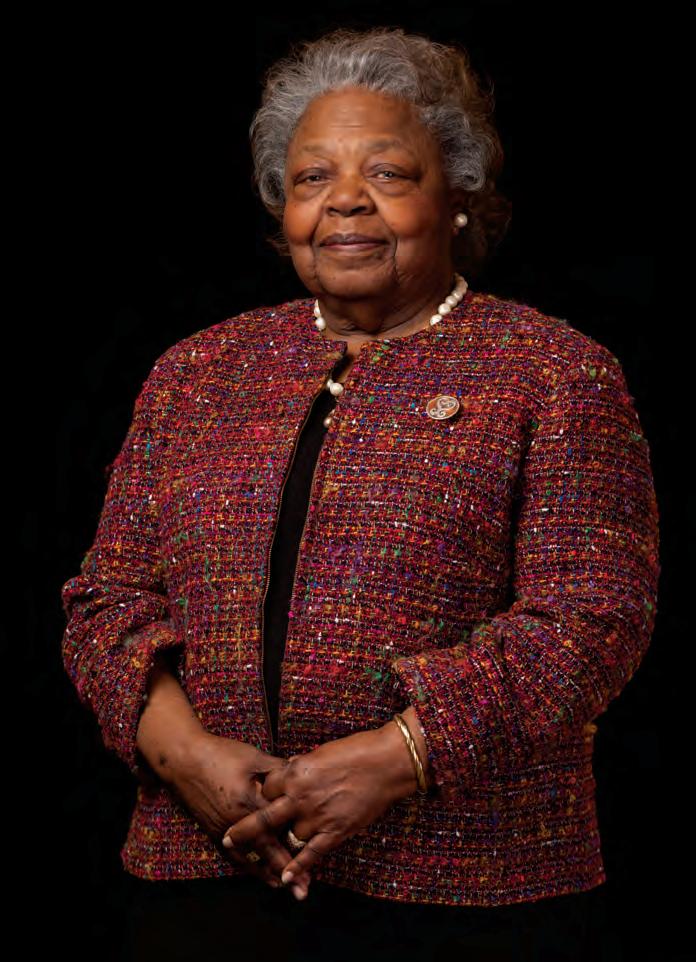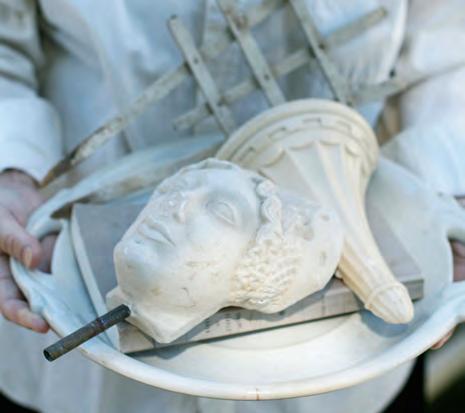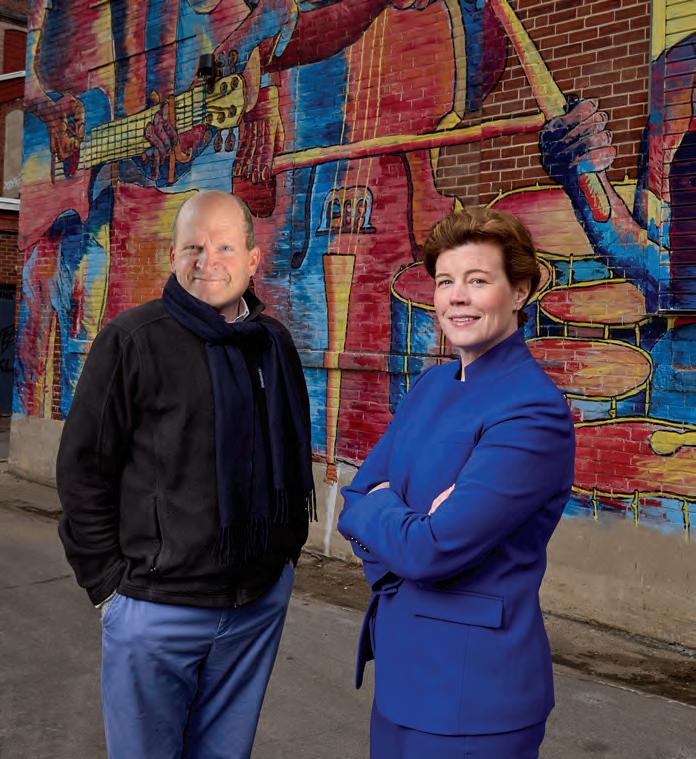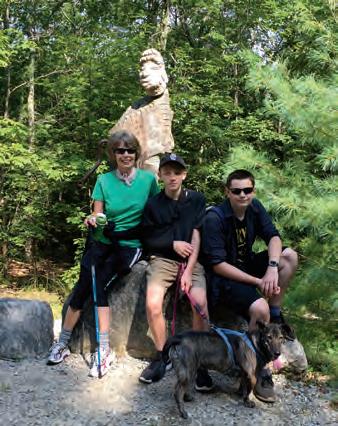
22 minute read
PORTSMOUTH: LOCALE HERO VERNIS JACKSON
mayor and help her create the Seacoast African-American Cultural Center in its present home inside the Discover Portsmouth Welcome Center.
Jackson organized Kwanza, the first chartered African-American women organization in New Hampshire, in 1974. Jackson says the Kwanza chapter started giving scholarships to African-American students for college. They also brought speakers and introduced other programs to spur interest in Black culture. Jackson says they decided to include men in their group, so they could do a wider variety of activities like art exhibits.
“One time we had this exhibit of African kings and queens that was sponsored by Budweiser,” Jackson says. “It was a national exhibit of photographs and other kinds of things that involved history of African kings and queens. It was a really, really great exhibit. I wish we could do it again.”
The exhibit was held at the former Connie Bean Community Center on Daniel Street. At the time, Jackson says she was working with the city to find a permanent location for SAACC. The cultural center was created in 2000 at what was then the former Portsmouth Public Library on Middle Street, the present home of the Discover Portsmouth Welcome Center.
Jackson says the creation of the African Burying Ground Memorial Park began by accident in 2003 when a construction crew unearthed the remains of the graves of 13 African slaves. Former Portsmouth Mayor Evelyn Sirrell asked Jackson to chair a committee to create a memorial park, which opened in 2015.
If the City of Portsmouth is viewed as one of the most diverse communities in New Hampshire today, Vernis Jackson may have planted the first seeds 60 years ago.
Through her community advocacy and ability to use education and conversation to bring people together, those seedlings yielded the Seacoast African-American Cultural Center and the African Burying Ground Memorial Park in Portsmouth.
“I am a talker,” Jackson says. “And in talking and talking all of the time, I just convinced other people that these things should be done.”
Originally from Savannah, Georgia, where her daughters reside, Jackson first came to Portsmouth in 1963 when her husband, Emerald, a member of the Air Force, was transferred to the former Pease Air Force Base.
Moving during the winter, Jackson says the cold air and snow came as a culture shock. “When I came here, I thought to myself, ‘Oh my gosh, what am I going to do? There is nothing to do for me,’” Jackson recalls. “The African-American community was scant.”
She decided that if she wanted to create community that would bring Black people together, “I had to make my own place.”
Jackson taught second and fourth graders in the Portsmouth public schools for 38 years. One of her students was Tom Ferrini, who would later become a Portsmouth
Jackson, who is now 90, beams when she reflects on such accomplishments.
“I don’t know how to even feel about it,” Jackson says. “It is just something down deep inside that makes me so proud. It is a really great feeling. I know I had really worked with kids in the community and I just loved doing that. Even today I wish I could be back in the classroom. My life has been beautiful.”
Jackson is pleased at the increased diversity in Portsmouth and New Hampshire compared to when she first arrived in the Granite State.
“There was a void here and, in some kind of way, I helped to fill that void,” Jackson says. “I am very, very happy about that.”
— Robert Cook
BEST PLACE / Reader’s Pick
The picnic area at this beautiful landmark, Beaver Brook Falls in Colebrook, is my favorite place. It is serene and peaceful, and incredibly beautiful year-round.

— Sandi Duval
Best Small Towns
I’ve been asked to hold forth on the best small towns in New Hampshire, but I’m not sure why. Maybe it’s because my hometown of Frost Heaves is the crabapple in that particular barrel, and folks figure I have a standard against which to judge a stinker from a blue ribbon winner.
Of course, to pick the best small towns, you have to decide what “best” means. For newcomers or people from away, it could mean a place with quaint boutiques and bistros serving coffee-like beverages that cost more than a new set of mud flaps. For others, it means dirt roads, peace and quiet, and neighbors who won’t bother you unless you’re at death’s door and maybe not even then.
In my travels, I’ve visited town halls, churches and better basements all over the Granite State and have stumbled on a number of grade-A locales that are worth a visit. One of my favorites is Tamworth, which is like a spiffed-up Frost Heaves with a historic summer theater (The Barnstormers) smack in the middle of town.
If you’re looking for sheer beauty and isolation, you’d be hard pressed to beat the town of Landaff, tucked up in the North Country. Then there’s Rumney, which has a lovely common and folks who put on hearty baked bean suppers with some regularity. (Pun absolutely intended.)
There’s nothing plain about Plainfield, where the town hall has a stunning stage backdrop painted by Maxfield Parrish, who once lived there. I’m also partial to Hancock, and not just because the whole of Main Street is on the National Register of Historic Places; it also has an excellent swap shop and has been the inspiration for a number of my stories.
Truth be told, New Hampshire has a host of great small towns. For most of us, the best town is the one we were brought up in, despite its having no particular redeeming qualities. But now we’re talking about Frost Heaves again, and I get teary just thinking about it. — Fred
Marple
Fred Marple is the main booster of the Town of Frost Heaves, NH, which, rather like Shangri-La, exists only in the minds of himself and a number of “believers” who usually have encountered it by taking a wrong turn in southwest New Hampshire during a blizzard. Visit fredmarple.com.
0pen Season For Antiquing
Just as spring bulbs pop up every year, so do the vintage treasures that can found at our state’s antiques shops. Visit some of designer Matthew Mead’s favorite haunts in every corner of New Hampshire. And for advice on how to incorporate those new finds in your home, check out Matthew’s story on page 86.
SOUTHWESTERN NH
Flying Pig Antiques • (603) 543-7490 • 13 Industrial Park Dr., Westmoreland
A multi-dealer shop close to Keene on the Vermont border. Unusual finds, ranging from interesting folk art and beautiful primitive New England antiques. Make sure to check out their calendar of dealer shows outside.
SOUTHERN NH
101A Antiques • (603) 880-8422 • 141 NH-101A, Amherst
Collectibles that span from early American through mid-century modern. Shop both booths and cases and save time to explore for furniture and bargains in the large basement area.
EASTERN NH
Parker-French Antiques
(603) 942-8852 • 1182 First New Hampshire Turnpike, Northwood
One of New Hampshire’s oldest and most beloved antique shops on the original antiques alley. Great mix of early primitives and home decorating accessories. Look for seasonal furniture displayed outside at the entryway.
COASTAL NH
Sage Farm Antiques • (603) 964-3690 • 5 Exeter Rd., North Hampton

First three days of the month occasional sale. Check sagefarmantiques. com for dates and times. Always fresh merchandise, including great vintage finds, furniture, fabrics and tabletop accessories.
CENTRAL NH
Antiques on Elm • (603) 606-1736 • 321 Elm St., Manchester
Fabulous store with multiple dealers and lots of great finds at fantastic prices. Knowledgeable staff and almost any collectible your heart desires. Furniture, vintage clothes. Early American and ’50s kitsch all with a flea market vibe.
NORTHERN NH
Old Post Office • (603) 539-8677 • 13 Industrial Park Dr., Westmoreland
Charming and quintessential New England antiques shop in the beautiful village of Ossipee. Enchanting displays and antiques from all eras in a vintage post office setting. Art, ephemera, furniture, dishes and more.
Rich with history, scenic views, good eats and classic New England architecture, Keene may be known as a college town, but it is also part hidden gem for the outdoorsman and local shopaholic, and part innovative hub for Granite State business owners thanks to the Hannah Grimes Center for Entrepreneurship.
Located at 25 Roxbury St., the center opened its doors to the community in 2006 thanks to the vision of founder and executive director Mary Ann Kristiansen after she saw a need to support the successful startup and growth of local small businesses from experiencing a gap in her own startup experience. “I moved to Buckminster (-Kingsbury) Farm in Roxbury in 1991 and started building a home-based soap-making business,” says Kristiansen. “Through my soap-making, gardening and farming contacts, I noticed that there was a shortage of markets and a shortage of business skills for local producers to succeed in those markets.
I started the Hannah Grimes Marketplace in 1997 to provide a market for local products and to provide business support for the makers of those products. The Hannah Grimes Center for Entrepreneurship was founded in 2006 to support the growth of a wider range of size, stage and sector of local businesses.”
The center provides the space, tools and connections that innovative entrepreneurs need to build strong businesses, thriving local economies and vibrant communities in the Monadnock Region through a business incubator program, coaching, workshops and a variety of programs. The hope? To create a broader vision of a sustainable, thriving local economy and vibrant community, built upon the region’s heritage, culture, natural resources and the civic-minded entrepreneurial spirit of its people.
“The co-working space is wonderful and welcoming in itself, and people have loved using it the last few years for a break from working alone remotely, but all of our different offerings and opportunities for connection are what are really bringing people through the door,” says Kristiansen.
From workshops and specialized educational and training programs to peer networking and learning, Kristiansen and her team have created successful models as the “soil” for people across a range of industries to come together and create solutions that fill the gaps that are not being met in the community.

The Business Lab is one of the center’s most popular offerings. It is a fast-paced, interactive and collaborative program of seven classes held over seven weeks, designed to help entrepreneurs create, refine, implement and pitch their business. It covers the essentials of business strategy, finance and profitability, and marketing and sales to help entrepreneurs define the fundamental purpose of their business and the core value it offers to their customers.
“At the end of the seven weeks, we have a pitch night where you see the culmination of businesses being started, growing and evolving, as each person delivers their final ideas in front of friends, family and the broader community. It makes me want to burst with pride,” she says. “Each of these entrepreneurs are beaming with joy, surprised at themselves for what they’ve been able to do and create and for the connections they’ve made along the way. We are just there to help give them the vehicle to carry their dreams forward.”
— Emily Heidt
CONCORD: LOCALE HEROES JOAN WOODHEAD & JULIANNE GADOURY

History lives in New Hampshire and nowhere more so than in its Capitol City where our state Legislature still meets in the same chambers it has occupied since 1819 and where the U.S. Constitution was finally ratified, in 1788, ensuring that it would become the blueprint for America democracy.
But there are as many ways to keep the past relevant and alive as there are unique historical resources (like Concord’s ungainly Gasholder) and devoted caretakers of those resources, like these two Locale Heroes who operate at different ends of Concord’s historic and isolated North Main Streeet: Joan Woodhead of the Pierce Manse and Julianne Gadoury of the Kimball Jenkins Estate.
“The Manse demonstrates democracy in action,” says Woodhead. “It was a small group of citizens that united to save a house that was the home of the President.” It’s hard to believe, but the Concord home of Franklin Pierce, our oft-disparaged 14th president of the U.S., was about to face the wrecking ball of urban renewal until a “brigade” was formed to save it. “They started in 1966 and moved the house in 1971 and opened it to the pubic in 1974. So it’s been around for a long time and with all volunteers,” says Woodhead, president of the Pierce Brigade, which has kept the Pierce Manse in shape and attractive with tours, concerts and lectures just about ever since.
One block closer to downtown (but still separated by the busy on-ramp to Interstate 393) stands the lovely mansion, carriage house and grounds of the Kimball Jenkins Estate which has served as an architectural treasure for the city since it was completed in 1882 and has served as event space, wedding setting, art school and studio. Under Gadoury’s guidance as executive director, the estate has blossomed with new life.
“We see this as publicly accessible green space and grounds for people to still interact with history but also with current, contemporary programming,” says Gadoury. Examples include hosting shows for Concord Youth Art Month that pack the historic block with the bustle of proud families and happy kids; an artist-in-residence program (currently featuing performance artist Gemma Soldati) and an arts- and history-based day camp designed to activate kids’ creativity. “People come here from all over. I hope it can be a link between New Hampshire past and the present — people aren’t going to come here if there aren’t things happening,” she says.
The stretch of North Main between these two outposts of the past is also rich with history, like the restored, mansard-roofed home of the Reverend Timothy Walker: Concord’s “founder” and first minister. The home has even recently attracted the attention of the Black Heritage Trail of NH.
The New Hampshire Historical Society — only a few city blocks away, but in a different world in terms of foot (and vehicle) traffic — has plans for outreach this summer to all of Concord’s historical leaders and resources to seek out more collaboration, says Gadoury, and both she and Woodhead see opportunities for working together.
There was a push for awhile to stage tours of the North Main Street district and explore its other historic treasures, recalls Gadoury. “But a lot of these houses are privately owned,” she says. “Not everyone wants someone standing out front talking about your home.”
— Rick Broussard
Peter Ramsey is many things to many people: family man, coach, lawyer, former state rep and present-day legislative insider, Manchester Citizen of the Year for 2020 and tireless supporter of arts and culture in the Queen City. To most people, though, he’s just that guy who always seems to be chatting and shaking hands in the entryway to the Palace Theatre before and after virtually every show.
As president and CEO of the Palace for a quarter of a century, it really is a second home to him. And as attuned as he is to the pulse of the state through his many board and committee roles, it’s the pulse of that historic and living theater that synchronizes with his own. For most of the past few decades, the whole city has relied upon the illuminated Palace marquee on Hanover Street as the pilot light for city culture.
“I’ve been downtown for 25 years, and 25 years ago it was dark,“ says Ramsey. “I mean dark economically, dark socially and, well, the streetlights didn’t work, so it really was a different time. We were just coming out of an economic recession and, over the years, a lot of really good-hearted people have called Manchester their home. Step by step we’re making progress.”

As he speaks, he’s standing at the rear of the Palace Theatre’s newest extension, the completely refurbished Rex Theatre on Amherst Street where a huge mural (one of many to recently grace downtown walls) brightens up the alleyways. The Rex was a decaying shell of a downtown movie theatre that now promises to bring an additional 50,000 people to enjoy Manchester nightlife and dining.
“The good news is that people want to live here,” says Ramsey. “We have a very diverse economy: a lot of high tech, a lot of medical, a lot of education, and that bodes well for the future.” When asked what the city needs to continue its recent surge, he replies, “The state must become a partner in essential items like mental health and support of education. It’s critical that the state realize that half the people in New Hampshire live in the cities.”
Liz Hitchcock, standing with Ramsey as a photographer adjusts his strobe for a portrait of them both, chimes in, “Truthfully, I think the biggest barrier to the city’s future is PR communications and our own heads. We need to think more forward and less backward and be excited for where we’re headed,” she says.
Like Ramsey, Hitchcock has been devoting herself to visionary work in Manchester. She and her husband, Jeremy, have worked behind the scenes since their tech company Dyn took up residence in the millyard a decade and a half ago, attracting a surge in young people seeking both places to live and places to have fun in Manchester. Among her recent entrepreneurial and investment efforts, Hitchcock brought The Bookery to Elm Street in the heart of downtown and developed The Factory on Willow — a 100,000-square-foot space nearby with an artist-in-residency program. Her vision is to attract more young creatives and more visionaries to create a snowball effect.
“ The Factory is full, residentially, and we have the 16 Airbnbs on-site, which really give a nice option for our event space and for our tenant, which is Double Midnight Comics.” The comic book connection to her vision might puzzle some, but she says, “It’s art. It’s all art. It’s all literary art, too. So it’s really a perfect fit.”
The last pieces to pull together on-site are the amphitheater, which the Factory’s food truck patio overlooks, and a new distillery. “We’re in the process of a national search for the distiller,” she says. “I think in the end, when you have something that works nationally or internationally, you can do it from anywhere.
“ The biomanufacturing movement that’s occurring right now in the downtown mills is internationally renowned, and it’s really sad that more Manchester people don’t understand the amazing stuff that’s happening right here,” she says, noting she took the artsy staff of Orbit Group, her tech and real estate company, to check it out. “We held the ghost heart,” says Hitchcock, with pure, nerdy enthusiasm. “They take the heart of a pig, take off all the DNA and then they ‘scaffold’ human DNA onto it.”
Hitchcock recalls the words of a woman who, after an unproductive series of economic development meetings, exclaimed: “All you have to do is one thing, and then keep on doing one thing over and over again and it will create such an amazing path forward.” She took those words to heart: “So we keep on doing new ‘one things’ over and over again to create some amazing culture in our city.”
— Rick Broussard
ROCK’N THE COAST
As New Hampshire Magazine’s youngest staff member by a decade, I’m the authority around here on young people things, like music venues and bars and weekend activities you can do without kids. I’m also a pretty big advocate for live music and heartily enjoy watching local bands perform their tunes. My favorite spot might just be the Button Factory Stage at WSCA in Portsmouth. Couched in an unassuming brick building at the back of a parking lot on Islington Street, right next to Loaded Question Brewing Company, the nonprofit community radio station brings in an impressive smorgasbord of musical talent. Austin Kinnie, assistant music director at WSCA, is the heart and soul of the operation, inviting idiosyncratic indie bands from Portsmouth, Portland and even New York City to grace the warmly illuminated stage. Shows often last three hours, with three different bands playing hour-long sets and local artists peddling their wares from pop-up tables lining the room. I’ve discovered some wonderful bands at WSCA shows and never fail to have an intimate, charming time. If you love music, art and community, stop by the Button Factory Stage. Sometimes, the best things are hiding in plain sight.
Other great Seacoast spots include the legendary Stone Church Music Club in Newmarket (what hasn’t already been said about this haven on the hill? Grab a 16-ounce PBR for me while you’re there), the underrated Cara Irish Pub & Restaurant in Dover (fun atmosphere, blue-collar locals, live music ‘til midnight, what’s not to love?), Wrong Brain in Dover (wacky, welcoming nonprofit arts collective and community activists who showcase bands of every ilk on their bustling basement stage) and Drift Art House in Portsmouth (vibrant, trendy gallery space featuring young artists from across the Eastern Seaboard with a hidden backyard concert space; last summer they hosted bi-weekly Friday shows with three-band billings and free cocktails courtesy of Dwyer’s Pub). The Seacoast may be in the unfortunate throes of a deep gentrification, but like mycelium sprouting after a forest fire, a new, young, thriving arts and music scene has risen from the ashes. Go support local creatives and cut up a rug, why don’t you.
— Caleb Jagoda
BEST PLACE / Reader’s Pick

The best surf break in New Hampshire: Rye on the Rocks/Bass Beach on the Rye-North Hampton town line. When the surf is up, the break offers easy access and consistent lefts and rights with an occasional tube. This winter has seen days of 4-to-6-feet surf and even a few hours with waves well overhead.

— Neil Herring
LOOKING FOR HISTORIC BRIDGES? We Got You Covered
New Hampshire is home to over 60 authentic covered bridges, 46 of which are over a century old. Preservation of historic covered bridges gained national momentum right here in the 1950s when Milton S. Graton of Ashland began using 19th-century craftsmanship to restore covered bridges. The Graton family still leads restoration efforts nationwide. Milton’s son, master bridgewright Arnold M. Graton of Holderness, has constructed 16 new covered bridges and restored almost 70 throughout the country. In addition, the current president of the National Society for the Preservation of Covered Bridges, Bill Caswell, resides in Hillsborough, making New Hampshire homebase for this group of volunteers who advocate nationally for preservation of historic bridges.
New Hampshire is home to several “record holder” covered bridges. The Cornish-Windsor Bridge is the longest wooden bridge in the United States and the longest two-span covered bridge in the world. There are seven historic covered railroad bridges remaining in the world and New Hampshire is home to five! Newport’s Pier Bridge is the longest at 228 feet. Clark’s Bridge at Clark’s Bears is the only covered railroad bridge still in active use. The 1889 Contoocook Railroad Bridge in Hopkinton is the oldest, and the Sulphite or Upside-Down Bridge in Franklin is the only surviving deck truss covered bridge.
Check out coveredbridgesnh.com for a complete checklist and map of the covered bridges in the Granite State. Short on time? There are clusters of historic covered bridges in the Monadnock Region (9), the Upper Valley (14), the Mount Washington Valley (9), and the North Country/Western Whites (20). Can you visit them all?
— Kim Varney Chandler, author of Covered Bridges of New Hampshire (Peter E. Randall Publisher)


Happy-go-lucky. Devil-may-care. Lighthearted. There are many words to describe those endlessly upbeat souls beaming light into the world, but the most well-known may just be “Pollyanna.” Ironically enough, the term often carries a negative connotation with it, implying the so-called Pollyanna has their head in the sand, ignoring the truth of the world. Veronica Francis is trying to change that.
“I was always called a Pollyanna throughout my years as a sort-of insult, like I wasn’t paying attention or couldn’t be very smart if I was that happy,” Francis, 58, says. “I feel like I’m doing something worthwhile to try and change that whole perception about a Pollyanna.”
As a member of the Pollyanna of Littleton Board of Directors, owner of the GoLittleton Glad Shop and president of the country’s only modern-day Glad Club, Francis strives to champion local lore while promoting an infectiously positive attitude. For those uninitiated to its history, “Pollyanna” is a 1913 novel written by Littleton author Eleanor Hodgman Porter, following the trials and tribulations of 11-year-old orphan Pollyanna Whittier. Sent to live with her wealthy and wicked aunt in the fictional town of Beldingsville, Vermont
(which shares more than a few characteristics with real-life Littleton), Pollyanna displays a relentless optimism in the face of hardship — opting to play “the glad game” whenever things get rough, finding something to be happy about no matter the circumstances. The book saw immense popularity, a handful of sequels and even received the Hollywood movie treatment in 1960 when Disney turned it into a beloved family flick. The message struck an immediate chord with Francis, who easily identified with the character’s inexorable joy.
“If you’re glad about something, you’re also thankful for something, and being glad brings you into the moment,” Francis says. “You can worry about tomorrow and you can feel bad about the past, but to play that glad game, it forces you to think about the moment right now — and, right now, it’s really windy and cold outside, but the sun is shining.”
In 2002, acclaimed New Hampshire artist Emile Birch created a bronze Pollyanna sculpture, permanently beaming to passersby in front of the Littleton Public Library — the same grounds where Porter’s grandfather once owned a house. Commissioned by the Eames family and spearheaded by Karen Keazirian, the sculpture was just the beginning; Keazirian started Pollyanna of Littleton, Inc., an orga- nization dedicated to spreading Pollyanna’s spirit, which Francis joined as one of the board of directors’ first members. The group visits schools, passes out stickers at community events and holds an annual “Glad Day” festival on the second Saturday of every June, where attendees “eat cake, decorate hats and have a little parade right in downtown,” says Francis. Francis continued on her crusade of kindness, starting the GoLittleton website in 2003 to share Pollyanna information and maintain an online presence, and opening the GoLittleton Glad Shop in 2019, selling a litany of Littleton and Pollyanna souvenirs. With the pandemic momentarily shuttering the shop’s in-person business in 2020, Francis took to the internet to unite her fellow Pollyannas. Inspired by the “Glad Clubs” of the 1920s who communally rejoiced over the titular character’s buoyant worldview, Francis started her own. Today, she boasts over 400 members — each of which receive a monthly “Glad Greeting” video and email from Francis, a digital reminder to cherish the latent positives found in each moment.
Francis believes the Pollyanna mindset “has added to the whole ‘up’ vibe of Littleton.” With its moniker as “The Glad Town,” its vibrant downtown lacking a single vacancy and its growing reputation as a White Mountains tourist destination (even for those uninterested in outdoor recreation), Littleton radiates an increasingly warm and inviting aura. Francis, and her boundless, but not baseless, enthusiasm, have a lot to do with that.
“I think of Pollyanna as a spunky, optimistic person,” Francis says. “She had her tough times, and people were not that nice to her, yet that little glad game caught on to the whole town. That’s what I’m trying to do here. I hope to do this for the rest of my life.”
Karen Keazirian has been doing it since 2002, when the sculpture was first unveiled, and remains unwaveringly invigorated by Pollyanna’s legacy. After seeing the long-term reverberations of Pollyanna’s positivity, how could she not be?

“It’s true in Littleton, New Hampshire, that when something positive and optimistic happens, it lasts for a very long time,” Keazirian says. “You look at Pollyanna’s feet — one foot’s ahead of the other — and the vibration is there to go ahead, grab it, throw your head back and put your arms out. As far as the sculpture goes, it speaks to a lot. It speaks to that optimism.”
— Caleb Jagoda
BEST PLACE / Reader’s Pick
Two of my favorite spots in NH are in different parts of the state, but they offer a similar experience: fresh air, a moderate hike and a view of the natural world. The Basin is located within Franconia Notch State Park (Lincoln, NH). Andres Institute of Art has over 50 man-made creations scattered throughout their own trails in Brookline.
— Jane Watson
BEST PLACES TO WANDER: Three Road Trips
New Hampshire’s topography can turn a casual Sunday drive into a followthe-dots game involving a dozen different roads, some numbered, some not. Signage is helpful, but GPS often is not, choosing the fastest way over the most scenic or interesting. These drives may be circuitous, but they are meant to be; the joy’s in the journey.
UPPER VALLEY AND WESTERN WHITES
Head north from Hanover on Route 10, alongside the Connecticut River through the beautiful villages of Lyme, Orford and the Haverhills. From Lyme’s 1808 white church and carriage sheds and the elegant Federal homes along The Ridge in Orford, to Haverhill’s Historic District of 18th-century buildings, you’ll have a quick course in early New England architecture.
Follow Route 10 through Bath, stopping at the state’s longest covered bridge, and Lisbon, where you turn onto Route 117. From hilltop Sugar Hill, where the meadows are blue with lupines in June, follow signs through Easton to join Route 112 just above Kinsman Notch. After stopping at Lost River Gorge, follow Route 118 to Warren, and Route 25A to climb over Mount Cube and back to Orford.
SQUAM AND CHOCORUA
From Ashland, follow Route 3 to Holderness and Squam Lake. For an eagle’s eye lake view, take Route 113 and watch for the short trail to Eagle Cliff. After stopping in Center Sandwich, take Route 113A to Wonalancet for views of Whiteface, Paugus and Chocorua. Drive through Hemenway Forest into Tamworth to see the beautiful gardens behind Tamworth Distilling’s tasting room. Route 113 continues to Chocorua, where a short side-track north on Route 16 reveals the postcard view of Mount Chocorua reflected in the lake.

Backtrack on Route 16 into Ossipee, following Route 25 west through Moultonborough to Center Harbor, on Lake Winnipesaukee. Route 25B leads to Route 3, returning to Holderness and Ashland
AROUND MONADNOCK

Getting Pickled THE FAST-GROWING SPORT LANDS A “DINK” IN THE SEACOAST
The sport — or rather, the social activity — called pickleball has spread across the state as fast as a popular TikTok reel. Just in case you haven’t noticed, many municipalities have covered outdoor, cracked and weed-filled tennis courts with fresh paint and new lines that define the smaller boundaries of the game, while recreation centers and YMCAs have added another set of stripes to the already busy maze of lines on their gym floors. Entrepreneurs are getting in on the game with All-Stars Pickleball taking over a vacant Old Navy in Concord’s near-dead Steeplegate Mall. On the Seacoast this summer, two tourney-ready facilities will offer the pickler’s dream for all-season pickleball with six courts, each divided with low partitions. Yes, keep that rally going without folks in the next court screaming, “Ball, ball!” as their errant whacks interrupt your near-perfect third shot. Those indoor facilities, New England Pickleball Club in Rye (open) and New Hampshire Pickleball in East Hampstead (under construction), will make the Seacoast the hottest spot to land the well-executed dink. There’s even a tournament — always fun, even just to watch — scheduled in the area for July.

— Susan Laughlin
Travel east from Keene on Route 101 through Marlborough, following signs left to the brick village of Harrisville, home of Harrisville Designs. Continue straight on Dublin Road, climbing over Beech Hill for views of Mount Monadnock, rejoining Route 101 at Dublin Pond. Circle the pond for glimpses of summer “cottages” built when Dublin was a noted art colony.
Follow Route 101 east, taking a right to Jaffrey. There another right on Route 124 leads to an ensemble of historic buildings in Jaffrey Center. After about 3 miles, turn left onto Fitzwilliam Road and cross Route 12 into Fitzwilliam, the postcard image of a New England village around its green. Route 119 leads to Richmond, where a restored Tramp House is opposite the library. Take Route 32 north through Swanzey Center (look right for a covered bridge) and back to Keene.
— Barbara Radcliffe Rogers










